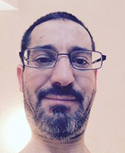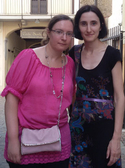 Alejo Montoliu wrote from Barcelona to say he was diagnosed with ChAc almost four years ago. He is the oldest of six children and has five children of his own; his Masters in Business Administration enabled Alejo to start a professional career.
Alejo Montoliu wrote from Barcelona to say he was diagnosed with ChAc almost four years ago. He is the oldest of six children and has five children of his own; his Masters in Business Administration enabled Alejo to start a professional career.
Unfortunately symptoms appeared and caused his early retirement from his business life. We wish him well and thank him for sharing his news.
 We received news from Ernesto Monterro in Spain about his family. His brother Mario had Deep Brain Stimulation in October of 2014 and is recovering at home; his dystonia has disappeared but he still has movement challenges, although his quality of life is better than before the operation.
We received news from Ernesto Monterro in Spain about his family. His brother Mario had Deep Brain Stimulation in October of 2014 and is recovering at home; his dystonia has disappeared but he still has movement challenges, although his quality of life is better than before the operation.
Siblings David and Pilar are not likely to benefit from DBS. We send our best wishes to all.
 Mike Koutis, who lives in Canada, recently wrote describing his illness and then outlining how he has down days, but because of family and friends' love and support, he's usually smiling and happy. "The worst symptom by far of my disorder is the extreme pain from my constant tongue biting," Mike wrote. "It can be almost unbearable at times. To my surprise and joy I have discovered that milkshakes greatly help to alleviate my pain and with my local burger chain offering tasty and reasonably priced milkshakes, I often have two a day."
Mike Koutis, who lives in Canada, recently wrote describing his illness and then outlining how he has down days, but because of family and friends' love and support, he's usually smiling and happy. "The worst symptom by far of my disorder is the extreme pain from my constant tongue biting," Mike wrote. "It can be almost unbearable at times. To my surprise and joy I have discovered that milkshakes greatly help to alleviate my pain and with my local burger chain offering tasty and reasonably priced milkshakes, I often have two a day."
"For something so simple to have such impact on how I feel, well, I just had to let you know! So I am writing mostly to educate those who will listen about Neuroacanthocytosis (NA), and to say thank you for milkshakes! I am an average guy with a positive attitude……..SMILE AND LIVE!!!!"
 We hear from Ezequiel in Madrid that Ana is finding different symptoms make movement more problematic. The neuro-stimulator inserted during her DBS operation a number of years ago is less effective and operated in a low stimulation mode but she has no chorea.
We hear from Ezequiel in Madrid that Ana is finding different symptoms make movement more problematic. The neuro-stimulator inserted during her DBS operation a number of years ago is less effective and operated in a low stimulation mode but she has no chorea.
They would like to come to the US for the meeting next May but will not be able to. Ezequiel sent the photo taken in August last year on holiday in Spain.
 Silvia Chuiz has written a small book about her sister Frederica's story, which was published in Italy in June. Silvia says she hopes "that people who read this understand that in the hard moments, even if it isn't simple, the important thing is never give up."
Silvia Chuiz has written a small book about her sister Frederica's story, which was published in Italy in June. Silvia says she hopes "that people who read this understand that in the hard moments, even if it isn't simple, the important thing is never give up."
Information about the book can be found on the publishers' website: http://www.gruppoalbatrosilfilo.it search for: NATA PER AMARE (Born to love)
 Gill and Gordon Parry, who lost sons David and Mark to NA and daughter Sian to epilepsy some years ago, continue tirelessly to raise funds for both conditions. They also continue to celebrate life, and they wrote to us recently to describe a birthday present Gill organised for Gordon: "an experience including a magnificent historic quarry tour in a specialised off-road vehicle" with "the high point a descent from 1500 feet with a mile long zip line back to the start." Gill thought this would be the ideal present for Gordon, and so, duly suited and instructed, Gordon enjoyed the experience, as evidenced by these photos. They’re now back in North Wales, continuing their fundraising efforts and planning a charity concert April 30th at St AsaphCathedral-more information to follow Gordon and Gill, we salute you!
Gill and Gordon Parry, who lost sons David and Mark to NA and daughter Sian to epilepsy some years ago, continue tirelessly to raise funds for both conditions. They also continue to celebrate life, and they wrote to us recently to describe a birthday present Gill organised for Gordon: "an experience including a magnificent historic quarry tour in a specialised off-road vehicle" with "the high point a descent from 1500 feet with a mile long zip line back to the start." Gill thought this would be the ideal present for Gordon, and so, duly suited and instructed, Gordon enjoyed the experience, as evidenced by these photos. They’re now back in North Wales, continuing their fundraising efforts and planning a charity concert April 30th at St AsaphCathedral-more information to follow Gordon and Gill, we salute you!
 Joy Williford-Willard writes that husband Mark attends water aerobics and a daughter gifted him membership to a puzzle-a-month club which he enjoys. Mark's older brother Eric Williford attended his son's wedding earlier this year.
Joy Williford-Willard writes that husband Mark attends water aerobics and a daughter gifted him membership to a puzzle-a-month club which he enjoys. Mark's older brother Eric Williford attended his son's wedding earlier this year.
 Two patients' families in Puerto Rico have met again after a couple of years. Juan Carlos Santiago wrote to say his wife Nadia and Vivian Rodrigues and her family enjoyed a reunion.
Two patients' families in Puerto Rico have met again after a couple of years. Juan Carlos Santiago wrote to say his wife Nadia and Vivian Rodrigues and her family enjoyed a reunion.
Part of their conversation was the meeting in Ann Arbor Michigan next May; both couples hope to be going.
